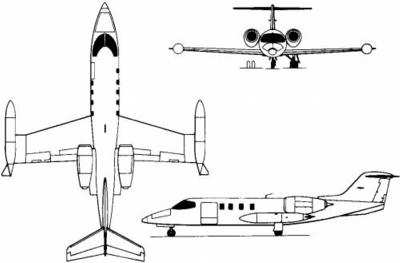Airplane Was Registered In Mexico, Had Completed A Medical Transport Flight
The NTSB has released a preliminary report stemming from an accident which fatally injured four people, who of whom have never been located. The plane went down in the Atlantic Ocean following takeoff November 19 from Fort Lauderdale/Hollywood International Airport (KFLL), Fort Lauderdale, FL. The commercial pilot and a physician on board were lost and presumed fatally injured. The copilot and a flight nurse were fatally injured. Night visual meteorological conditions prevailed, and an instrument flight rules flight plan was filed for the positioning flight from FLL to Cozumel, Mexico.

The airplane had just completed an air ambulance flight for Air Evac International from San Jose, Costa Rica to FLL, and was repositioning back to its base in Cozumel, Mexico.
Preliminary voice and radar information provided by the FAA revealed the airplane had departed Runway 10 at approximately 1950, climbed straight ahead to an altitude of 2,200 feet, at an approximate groundspeed of 200 knots, when the pilot requested radar vectors back to runway 10L at KFLL due to an "engine failure." The controller directed the pilot to maintain 4,000 feet and turn to a heading of 340 degrees. The pilot replied, "Not possible" and requested a 180-degree turn back to the airport.
At 19:52:34, the pilot declared a "mayday" and requested vectors back to KFLL. Over the approximately three minutes that followed, the pilot requested vectors to the airport multiple times. While the pilot requested, received, and acknowledged additional radar vectors to the southwest from ATC to return to the airport, the airplane continued its slow turn and descent to the north. During the approximately two minutes that transpired after the pilot declared his intention to return to FLL, the airplane descended to 900 feet and slowed to140 knots as it flew northbound, parallel to the shoreline and away from FLL.

At 19:53:42, about 700 feet and 150 knots, the airplane initiated a left turn towards shore. The airplane continued its descending left turn until radar contact was lost at 100 feet and 150 knots on a southwesterly heading, at 19:55:42.
The pilot was issued a commercial pilot certificate by the government of Mexico, with ratings for airplane single- and multi-engine land, and instrument airplane. His most recent medical certificate was issued August 22, 2013. According to the operator, the pilot had accrued 10, 091 total hours of flight experience, of which 1,400 hours were in the 30-series Learjet.
The copilot was issued a commercial pilot certificate by the government of Mexico, with ratings for airplane single-engine, airplane multiengine land and instrument airplane. His most recent medical certificate was issued on June 26, 2013. According to the operator, the copilot had accrued 1,235 total hours of flight experience, of which 175 hours were in the accident airplane make and model.
According to FAA and maintenance records, the airplane was manufactured in 1979. Its most recent continuous airworthiness inspection was completed November 4, 2013, at 6,842 aircraft hours.
At 1953, the weather reported at Fort Lauderdale/Hollywood International Airport (FLL), located 6 miles southwest of the accident site included few clouds at 2,500 feet and a scattered layer at 6,500 feet. The wind was calm and visibility was 9 miles. The temperature was 23 degrees C, the dew point was 22 degrees C, and the altimeter setting was 29.93 inches of mercury.
Wreckage was recovered from the ocean surface and taken to the U.S. Coast Guard Station Fort Lauderdale, Florida.. Examination by NTSB showed the wreckage contained exterior aircraft sheet metal skin, seat cushions, and luggage. The sheet metal skin showed no evidence of inflight or post-crash fire, and all fractures and tears were consistent with overload failure.
 ANN's Daily Aero-Term (05.01.24): Say Altitude
ANN's Daily Aero-Term (05.01.24): Say Altitude ANN's Daily Aero-Linx (05.01.24)
ANN's Daily Aero-Linx (05.01.24) Classic Aero-TV: Korean War Hero Twice Reborn
Classic Aero-TV: Korean War Hero Twice Reborn Airborne 04.29.24: EAA B-25 Rides, Textron 2024, G700 Deliveries
Airborne 04.29.24: EAA B-25 Rides, Textron 2024, G700 Deliveries Airborne Affordable Flyers 05.02.24: Bobby Bailey, SPRG Report Cards, Skydive!
Airborne Affordable Flyers 05.02.24: Bobby Bailey, SPRG Report Cards, Skydive!




